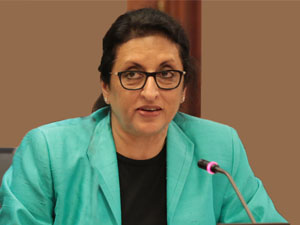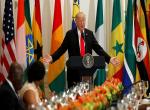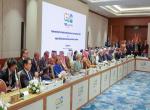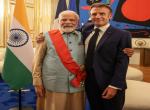When Prime Minister Narendra Modi and US President Barack Obama met in Paris on the sidelines of the crucial climate change conference, it was their sixth bilateral meeting in a little over one year, a very impressive tally by any reckoning. On Climate, PM Modi affirmed, “India will fulfill expectations from it and its responsibilities...the country is working to take forward development and (protecting) environment together,” sending a clear message to skeptics and, especially in the light of US Secretary of State John Kerry’s statement that India would be a “challenge” at the climate conference, that India stands committed to meeting its global obligations.
While this meeting focused more on climate issues, the two leaders took time to review the state of India-US relations and discussed ways in which to further deepen the strategic partnership on bilateral, regional and global issues. Both seemed satisfied at the positive trajectory achieved during 2015, beginning with President Obama’s highly successful visit to New Delhi as Chief Guest at India’s Republic Day celebrations and continuing with a spate of activities during September 2015 that saw PM Modi back in the US (New York) for the second time within a year, the first visit to the Silicon Valley by an Indian PM since Jawaharlal Nehru, the launch of the Strategic and Commercial Dialogue between the two countries, the first US-India-Japan ministerial level trilateral dialogue and a meeting of the US-India Business Forum. The year end sees India’s defense minister in the US who is there to discuss a range of “proposals for co-production of top-notch military equipment as well as bolstering maritime security, counter terrorism and intelligence-sharing between the two countries.”1
The importance of both countries to each other, and more especially as partners for peace and stability in Asia and the Indo-Pacific, safeguarding global commons through deepening cooperation on counter-terrorism, radicalism and cyber security is not lost on either India or the United States. This is amply reflected in The US-India Joint Strategic Vision for Asia-Pacific and the Indian Ocean Regions. Besides this, bilateral issues like defence, trade and commerce are important areas of cooperation and have made remarkable progress during the year.
Defence and DTTI:
Defence relations have made impressive gains with the US emerging as India’s largest weapons supplier, overtaking Russia, Israel and France. This has so far been mainly through the US Foreign Military Sales Route but both countries are committed to move from a traditional buyer-seller relationship to "co-production, co-development and freer exchange of technology” through the Defence Trade and Technology Initiative first proposed in 2012 by Secretary of Defense Leon Panetta, who at that time directed his Deputy Secretary of Defense, the current Defence Secretary, Dr. Ashton Carter, to undertake an initiative to provide increased U.S. senior level oversight and engagement with India. The aim was clear. To look for ways that would eventually include collaboration in "defense technology transfer, trade, research, co-development and co-production for defense articles and services, including the most advanced and sophisticated technology."2
India’s huge demand for the modernization of its defence sector along with relaxation of export controls on defence technologies by the US and significant cuts in American defence spending, have led American defence contractors to look for investment opportunities in the Indian market. This could be a win-win situation for both. Co- production and co-development would also provide a large employment base and sustain several thousands of jobs for American companies, while modernizing Indian defence industry. Co-production has been the thrust of discussion in all the dialogues between India and the US. The idea of co-production also resonates well with PM Modi's 'Make in India' initiative to strengthen India's defence industrial base.
Four technology defence hardware were identified as 'pathfinder' defence projects: RQ-11B Raven Unmanned Aerial System; Roll on/roll off kits for the C-130J aircraft; Mobile Electric Hybrid Power Sources; and Uniform Integrated Protection Ensemble, along with cooperation on aircraft carriers and jet engine technology. All of these projects have a stand-alone value and simultaneously lay down the foundation for future co-development and co-production initiatives. These initiatives were cleared in record time and talks are at an advanced stage now to finally clinch all of these at the earliest.3
For its part, the Indian government has taken concrete steps to create a proper environment by enacting reforms in the defence sector. One of the first steps in this direction was to increase the Foreign Direct Investment (FDI) in the defence from 26 percent to 49 percent with an option to increase it to 100 percent if the deal involves high-end technology transfer and is approved by the MoD.
The government of India has also asked the defence establishment to revisit an 11-year-old proposal from the Pentagon that will enable India and the US to grant mutual access to each other's military bases, refuel and replenish warships and fighter planes and, in a contingency, participate jointly in multi-nation military operations. There is an expectation that the present government would try to resolve this gridlock by evaluating the importance of signing the foundational agreements in order to further bolster defence cooperation.4
Recently, the Indian army announced its decision to buy 16 Sikorsky S-70 Seahawk Helicopters for its multi-role helicopter requirement that is estimated to be worth $1 billion. Defence Minister Manohar Parriker-led Defence Acquisition Council (DAC) has also cleared the acquisition of four more P8-I long-range maritime patrol aircraft for almost $1 billion that would be used for maritime patrols in the Indian Ocean in the backdrop of growing Chinese naval presence in the IOR. India and the US are also negotiating an $885-million deal for 145 M-777ultra-light howitzers which will eventually be made in India. India has various other projects in the pipeline with the US.5
The Pentagon has given license approval for the co-production of two key projects - one for the joint production of an aircraft carrier for India and the other for the manufacture of aircraft engines. The aircraft carrier group has made very good progress and talks are at an advanced stage regarding modalities to be adopted for aircraft carrier cooperation. This is a military to military model of cooperation enjoying political support at the highest levels in both countries and is likely to fructify soon. The Jet engine group on the other hand is about three to four months behind schedule and there are some structural challenges since the IPR for this technology is held by the US Corporate sector and on the Indian side the interlocutor is the DRDO, considered to be an impediment to defence production and modernization even in India!! The US Department of defence has only an advisory role and cannot foresee the possibility of an outright transfer of technology by private American companies as desired by the DRDO. This would mean an intervention from the highest quarters and a non-bureaucratic flexible approach by India, perhaps even starting the project from scratch, giving the US manufacturers the option to choose their own partner from among an Indian corporate house and opt for a Joint Manufacturing model which has advantages for both.6
These projects fit in with the Modi’s vision of “Make in India.” Focused working groups to move these initiatives forward have been set up and such successful collaborations have the potential to impart India greater strategic autonomy and prestige in a changing global scenario. But to implement the Indian PM’s positive vision for India, the Indian bureaucracy must shed its inertia and overcome the lack of strategic knowledge and priorities amongst the civilian staff in the DRDO and the MOD. India must not remain bound by history but should recognize the challenges and move forward. Time is an important element in the conclusion of important defense deals and the US too should adopt a ‘quick action’ top-down approach – as was done during the nuclear deal - in clearing projects with India as the US too has a major stake in doing business with India and in ensuring India’s rise.
Asia-Pacific:
On September 29, 2015 United States Secretary of State John Kerry hosted the inaugural U.S.-India-Japan Trilateral Ministerial dialogue with Indian External Affairs Minister Sushma Swaraj and Japanese Foreign Minister Fumio Kishida on the sidelines of the 70th United Nations General Assembly in New York. Representing a quarter of the world’s population and economic production power, the three countries highlighted their shared support for peace, democracy, prosperity, and a rules-based international order.7
The U.S. rebalance to the Asia-Pacific under the Obama administration, India’s new Act East Policy under Prime Minister Narendra Modi, and Japan’s reinvigorated role as a ‘proactive contributor to peace’ under its premier Shinzo Abe, have all been powerful indicators of the importance these players attach to the region. All three props of the triangle have also been strengthened recently, with positive momentum seen in U.S.-India, U.S.-Japan and India-Japan ties over the past year.8
For India, the Look East policy has been a cornerstone of its foreign policy initiatives since the 1990’s when it embarked on its economic transformation. Since then India has been stepping up its engagement with ASEAN and is now recognized as an important economic, political and security player. India’s aspirations to be a global player in the international arena combined with increasing Chinese assertiveness in the South China Sea make it necessary for India to play a more involved role in East Asian geo-politics to safeguard its economic and security interests.9
India’s Look East policy has therefore become Act East. As India readjusts and revitalizes its Look East Policy, it, along with the other Indo-Pacific nations has begun to form the nucleus of middle power coalition building in a region where it has core strategic and economic interests. Areas of cooperation include security dialogues, intelligence exchanges, military capacity building, technology sharing, maritime cooperation and joint naval exercises, agenda setting for regional forums and coordinated diplomatic initiatives.
To bolster its Act East policy, India has embarked upon an ambitious and practical strategy of revamping its naval capabilities and the Indian Navy today is among the top-five navies in the world. India’s naval influence in the Indian Ocean is already significant and has increased greatly in the Indo- Pacific as well as a response to the US Pivot. India has stepped up its joint maritime exercises to include Japan and Australia recently and today its maritime engagement encompasses the major powers, regional actors and even the smaller states of the Indian Ocean littoral besides its engagements in the Indo-Pacific. Thus India’s role in East Asia is complementary to the US re-balance or pivot to Asia.10
South Asia and US Pak Policy:
While the US-India Joint Strategic Vision for Asia-Pacific and the Indian Ocean Regions showed unprecedented convergence between the two countries, this common vision does not unfortunately extend to the west of India and the true potential of this partnership therefore remains unfulfilled. There are gaps between expectations and achievement—some of them are historical, and some because of divergent perceptions.
India finds it difficult to reconcile to U.S. policy on terrorism and its attitude toward Pakistan. Washington's over-eagerness to accommodate Pakistani demands and perceptions accompanied by an inability or unwillingness to penalize Pakistan, despite the harsh reality of Pakistan's continued support for terrorism, remains inexplicable to India. While the US seems aware that this tacit support by it has emboldened Pakistan to resist demands to dismantle its terrorist infrastructure, it is reluctant to exert pressure on Pakistan to act firmly against terror. One such case is the US handling of the Pakistani-American David Headley, whose role in the 2008 Mumbai attacks is well-known. But the U.S. reluctance to allow India free access to Headley is baffling and has strengthened Indian doubts about U.S. credibility in prosecuting terrorism cases associated with Pakistan. The promptness with which Headley was allowed a plea bargain and the U.S. refusal to assist Indian investigators of his links to LeT and his role in the Mumbai attacks have upset India.11 Neither has the US been able to get Pakistan to act against Hafiz Saeed, who continues to roam freely and make inflammatory speeches in Pakistan despite a bounty having been placed on his head. This discrepancy in US policy despite a formal counter-terror cooperation mechanism between India and the United States is puzzling. India is baffled about what precisely are US security interests in Pakistan and why they are so important that the US is willing to disregard India’s sensitivities especially at a time when the US and India are trying to forge convergences in their foreign policy and security interests.
More recently, the US-Pakistan Joint Statement at the end of Pakistan PM Nawaz Sharif’s visit to Washington in October 201512 and the reference therein about India and Pakistan both having “mutual” concerns about terrorism is perplexing.13 Equally confounding is the lack of a suitable response from the US when just a couple of days before Nawaz Sharif’s visit to the US, its Foreign Secretary, Aizaz Chaudhary issued a statement that Pakistan would use low-yield tactical nuclear weapons to forestall any possible advance of Indian troops under New Delhi’s “Cold Start” doctrine.14 This insolence and American unwillingness to exert pressure on Pakistan over its expanding nuclear arsenal, the continuing Sino-Pakistan nuclear nexus, and the recent announcement of the construction of a China-Pakistan Economic Corridor that will pass through Indian territory, POK, raise the question as to where Pakistan gets this level of confidence from.15
US actions demonstrate an element of contradiction in its policy in South Asia. On the one hand the US claims to view the US-India relationship as an important factor in the region to stabilize Afghanistan and sees a ‘commonality of interest” with India to ensure “peace and stability of a democratic Afghanistan,” while at the same time it is facilitating a reconciliation process in Afghanistan with Pakistan’s assistance that limits India’s role and impinges on regional stability and India’s genuine security concerns.
Concluding Remarks:
Despite challenges, India and the United States are bound by common values, people to people interactions, soft power linkages and a basic understanding of each other that brings a special dynamism into this partnership. It is in the interest of both nations to create a durable strategic partnership, and transform relations into a “defining partnership of the twenty-first century.” While the US must show sagacity and treat India as an equal partner, India too needs to realistically assess its core strategic and developmental interests and make itself sufficiently useful to Washington. The US and India can build a strong partnership while simultaneously advancing their respective strategic goals as there exists a strong underlying commonality of interests to improve bilateral relations and collaborate increasingly in multilateral fora. While there is a lot of goodwill and bonhomie between the two leaders, a sustained effort by the senior officials in both countries is also needed to maintain a continuum as the US readies itself for a new Administration in 2016.
Endnotes
- The Times of India, 30 November 2015.
- For details see, http://archive.defense.gov/pubs/US-IND-Fact-Sheet.pdf
- See, http://www.indiandefensenews.in/2015/08/us-seeks-pathfinder-projects-to-boost.html
- Sujan Dutta, Revived: plan to give access to bases, available at, http://strategicstudyindia.blogspot.in/search/label/India?updated-max=2015-01-24T00:10:00%2B05:30&max-results=20&start=900&by-date=false
- For details, see http://www.dsca.mil/tags/india
- Based on interactions with US officials, November 2015.
- http://www.state.gov/r/pa/prs/ps/2015/09/247483.htm
- http://thediplomat.com/2015/10/why-the-new-us-trilateral-dialogue-with-japan-and-india-matters/
- For details about India and ASEAN, see, http://mea.gov.in/aseanindia/index.htm; http://www.asean.org/asean/external-relations/india/item/overview-of-asean-india-dialogue-relations
- Daniel Twining, “An Asian post-election checklist for Obama, Nikkei Asian Review,November 5, 2014. SD Muni, Vivek Chadha, editors, Asian Strategic Review 2014 - US Pivot and AsianSecurity, IDSA and Pentagon Press, New Delhi, 2014. p. 7 . For details see, Congressional Research Service, Pivot to the Pacific? The Obama Administration’s Re-balancing Toward Asia, March 28, 2012,http://www.fas.org/sgp/crs/natsec/R42448.pdf and Mario Del Pero, US: Which GrandStrategy for Asia and China? ISPI Analysis No. 187, July 2013. - See more at: http://www.vifindia.org/article/2014/november/28/us-rebalance-to-asia-an-assessment#sthash.WJg7Glqn.dpuf
- For more details, please see, http://www.heritage.org/research/reports/2013/04/beyond-the-plateau-in-us-india-relations; http://foreignpolicy.com/2014/07/30/indo-u-s-relations-moving-beyond-the-plateau/;
- https://www.whitehouse.gov/the-press-office/2015/10/22/2015-joint-statement-president-barack-obama-and-prime-
minister-nawaz - http://www.thehindu.com/news/national/uspakistan-joint-statement-what-india-should-watch-out-for/article7795346.ece
- http://thediplomat.com/2015/10/pakistan-clarifies-conditions-for-tactical-nuclear-weapon-use-against-india/; http://nationalinterest.org/blog/the-buzz/pakistan-wants-battlefield-nukes-use-against-indian-troops-12200.
- https://www.quora.com/Why-is-India-not-objecting-to-the-CPEC-passing-through-PoK
Published Date: 9th December 2015, Image Source: http://www.deccanchronicle.com
(Disclaimer: The views and opinions expressed in this article are those of the author and do not necessarily reflect the official policy or position of the Vivekananda International Foundation)










Post new comment